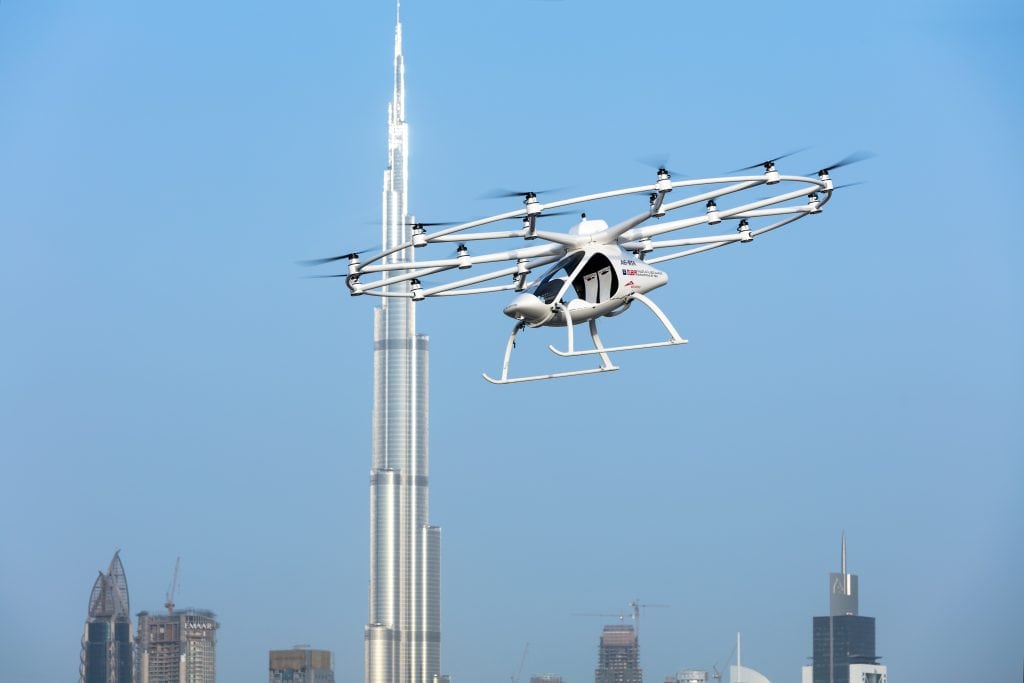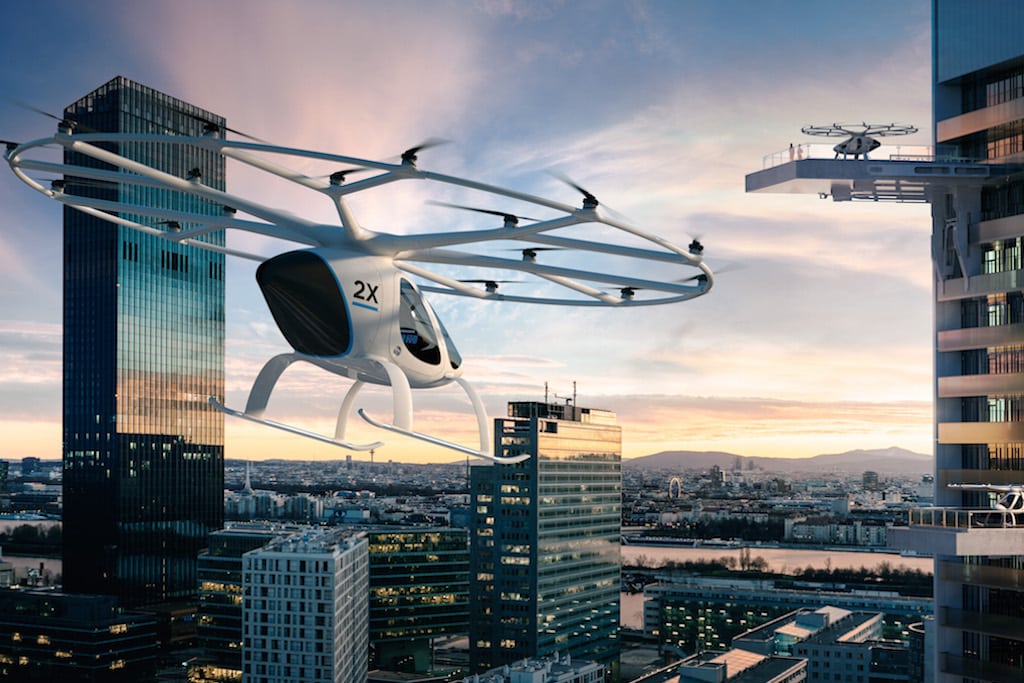Skift Take
Passenger drones are edging their way to becoming viable options for travelers transferring to and from airports. Airlines should explore how they can take advantage of this technology through potential upgrades and loyalty points before being left behind.
This sponsored content was created in collaboration with a Skift partner.
This article is part two of two in The Vanguard of Kinesis, a series exploring the autonomous and high-speed future of short haul transport. This series is sponsored by CarTrawler.
Drones have advanced from specialized military hardware to a part of everyday life in less than a decade. However, interest in these systems has gone into overdrive in the past twelve months following Volocopter’s much publicized unmanned test flight of its air taxi in Dubai and Boeing’s acquisition of Uber partner Aurora Flight Sciences Corporation.
Airlines Have a lot to Gain
The possibility that autonomous drone shuttles will be transferring travelers to and from the airport in the near future may not be as unlikely as many think. This is bad news for taxi drivers, but airlines should view this with a positive gaze, as there could be potential to benefit from this new form of mobility.
A shrewd airline carrier may see the possibility to upsell premium travelers on a package that incorporates rapid transport to and from the airport. Once the technology becomes more mainstream, a larger shuttle service for economy passengers could be feasible, too. This opens up the option for premium passengers to accumulate additional loyalty points or air miles during their drone transfer. Travelers could also potentially hail a drone to bring them to the airport through their carrier’s app and pay for the service using previously accrued points.
It’s likely that airborne drone passengers will be more likely to trust established airlines over ridesharing companies like Uber to fly them to their destination due to the decades of experience in passenger comfort and safety, extensive existing infrastructure, and brand trust airlines have built up over years. This means that carriers that back these systems at an early stage could open up a world of ultra-short distance airborne transfer options to their customers, while also taking a cut of the ridesharing industry.
Today, the global taxi market is valued at $108 billion, which is triple the current valuation placed on the ridesharing market, that currently stands at $36 billion. However, the taxi market is expected to shrink rapidly as more autonomous transfer options are rolled out. Goldman Sachs expects the ridesharing industry to grow to $285 billion by 2030.
In 2016, 29.5 percent of those traveling to JFK arrived by rail, train, or subway, 15.6 percent arrived by taxi, 8.9 percent took an Uber or Lyft, and 3.3 percent traveled via limousine, according to a report from The Port Authority of NY & NJ. It could be assumed that in its infancy, drone transfers will be both costly and point-to-point –– and thus be more likely to hit the limousine, taxi, and ridesharing share of the market. With passenger numbers at JFK expected to swell to 75 million in 2020, and on to 100 million by 2050, the potential revenue generated by airlines disrupting this market could be in the billions.
The Volocopter Takes Flight
With Airbus and Boeing working on autonomous passenger drone systems, it’s time to consider the reality of this future technology. German company Volocopter, which is backed by automotive giant Daimler and partnered with Intel, has developed an 18-rotor two-person autonomous air taxi which is capable of a 30 minute flight. “The Volocopter is optimized to be a very safe and stable option for short flights within cities,” said Helena Treeck, senior global PR manager for Volocopter.
The firm staged a test flight in September 2017 for Sheikh Hamdan bin Mohammed bin Rashid Al Maktoum, the crown prince of Dubai, as part of the United Arab Emirates’ plan to lead the Arab world in high-tech innovation. “Dubai has the goal of automating 25 percent of its public transport by 2030, so leaders want autonomous buses, trams, cabs, and most importantly, air taxis,” said Treeck. “There was a completely autonomous flight in Dubai –– meaning no human was piloting it –– which was a huge step forward.”
In terms of a roll-out timeline, the team at Volocopter believes there will be a commercial point-to-point route within three years. The example used is New York’s JFK Airport to Manhattan –– a journey which the Volocopter could undertake in twenty minutes, compared to the full hour it would take a commuter on public transportation.

Photo Credit: Nikolay Kazakov
It should be noted that because the Volocopter is classed as an ultralight aircraft, its weight is restricted to 992 pounds, or 450 kilograms, in total. This means that a family of four with large bags traveling from JFK to Manhattan would need three Volocopters to transport everyone. This could prove to be impractical and a costly deterrent for big groups or people with a hefty amount of luggage. However a businessperson traveling with a small bag or laptop, rushing to a meeting armed with a corporate credit card or a carrier’s app brimming with loyalty points, might jump at the chance to be in the city in twenty minutes.
CarTrawler, a travel tech platform powering transport solutions worldwide, has produced an app based on this concept, allowing travelers to book taxis and other airport transfer options and pay with customer loyalty points. The app was developed for CabForce, a provider of taxi booking solutions, which was acquired by CarTrawler in 2016. Applications founded on similar models will potentially be adapted as part of a “Mobility as a Service” system for future technology. Airlines could display a list of available airport transfer options to the traveler, including hyperloop, drone, autonomous cab, or even autonomous bus –– all of which could be covered by the customer’s points, provided they remain brand loyal.
Airlines that want to avoid being blindsided by disrupters –– like the taxi industry was by Uber –– should research the possibilities of utilizing “Mobility as a Service” software powered by artificial intelligence. This way, they can control the journey, instead of simply being a cog in the larger machine. Whether passengers are hurtling from San Francisco to Los Angeles in a hyperloop or buzzing from an airport to a rooftop in a Volocopter, one thing that’s for sure is that powerful, intelligent apps will be at the helm.
Passenger drones look to be an inevitability to many. However, they will require years of safety testing, infrastructure development, and financial investment before they’re rolled out. Once they are, they’ll open up a multitude of transfer options to those airlines that are shrewd enough to recognize their potential early on, by upselling premium passengers or allowing loyal customers to pay for transfers using a loyalty point-based app –– and for airlines, these potential opportunities are only tip of the iceberg.
This content was created by CarTrawler and published by Skift’s branded content studio SkiftX.
Have a confidential tip for Skift? Get in touch
Tags: airlines, business traveler, cartrawler, drones, ridesharing, volocopter
Photo credit: Volocopter

